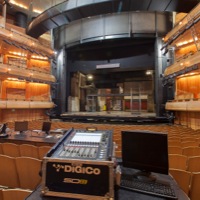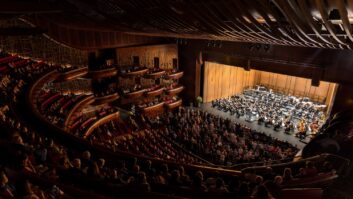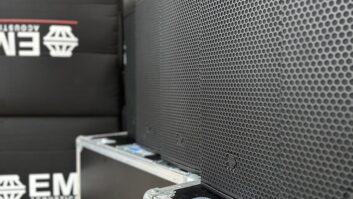
Glyndebourne Opera House in the picturesque countryside of East Sussex may be renowned for its superb performances and upmarket picnics but a new audio system has recently added high technology to the operatic mix, writes James Christopher.
It may seem like something of an oxymoron that a world-class opera house such as Glyndebourne in the south-east of England, which attracts some of the planet’s greatest singers – and most discerning audiences – would require an audio reinforcement system of any kind. But in today’s world of increasingly sophisticated productions and the demands they place on classically designed acoustics it’s not so surprising.
The theatre’s head of sound, Simon Cassford, tells Installation: “We had been looking to upgrade to a
high-quality but visually unobtrusive sound reinforcement system for some time and we were looking for a truly innovative solution.”
Earlier this year, Stage Electrics won the contract to design and install the new system. The company is no stranger to Glyndebourne; in an extensive upgrade programme in 2010, under the auspices of Glyndebourne lighting manager Keith Benson, it equipped the world renowned opera house with an ETC dimmer and control installation, along with Avolites dimmers for the company’s annual touring programme.
UK FIRST
The move saw the first UK installation of ETC’s new lower-current Sensor dimmer modules fitted with 6A and 10A miniature circuit breakers, allowing the original low-diameter wiring installation to be reused.
Ten ESR36N ETC Sensor Enclosures, fitted with a mixture of 3kW, 5kW, Contactor, Emergency and the new 10A version of ETC’s popular dimmer module, were provided. Two ETC EOS lighting consoles were also chosen, one as the main in-house desk and the other for use at the production desk for plotting. The latter can also be used for touring, complete with EOS Remote Processor Unit (RPU) back-up. An ETC Net3 network was also installed, while 120 ways of Avolites Art 2000 Series portable dimmers spread over three dimmer racks serves Glyndebourne On Tour’s requirements as well as parts of the theatre that require extra dimming provision, particularly the fly tower grid.
The final touch was an ETC Unison Paradigm control system, with an additional ETC ESR36N Enclosure to house ETC ER10AF 2.3K dual relay modules. These are controllable via two bespoke ETC panels complete with LCD touchscreen and push buttons, as well as from existing push button panels – all using the existing cabling infrastructure.
Stage Electrics’ other contribution has been to upgrade the bespoke stage manager’s desk it designed and manufactured in-house, to offer the latest features and facilities that its new range provides.
LATEST INSTALL
On the company’s team for the latest installation were designer James Gosney, account manager Adrian Searle and project manager Keith Samphier.
The touring aspect was also considered in the new audio system’s design. Outside the headline summer season in Sussex, the company tours its productions extensively and the new control end – a DiGiCo SD11 control surface with one installed and one flightcased and portable D-Rack – allows any audio production to hit the road running.
Says Cassford: “Stage Electrics’ system design gives us the option of either full hands-on mixing from the DiGiCo SD11 console, at various locations in the auditorium, or via an Allen & Heath IDR8 that provides simple remote control with presets for various set-ups from anywhere in the house. The whole system, along with the new loudspeaker arrays, sounds beautifully pure and clear.”
Gosney explains that Glyndebourne’s original brief for its new loudspeaker system was to replace a previous and more conventional system using 12in horn boxes that, for sightline reasons, had to be placed in locations that were partly acoustically shaded by architectural elements such as balcony fronts.
He says: “Our brief was: they were looking for a new audio system; they didn’t want to see any loudspeakers; the system would be used purely for occasional background singer reinforcement and to provide sound effects for specific productions.”
Stage Electrics’ chosen loudspeaker solution was a compact and slender system from K-array. Stacking several modules vertically either side of the proscenium arch allows sound beams of 100° horizontal dispersion but just 10° vertically to be directed at, respectively, the stalls and three balcony tiers.
And it turned out that Glyndebourne’s physical structure was also perfectly suited to the Italian manufacturer’s products.
Says Gosney: “Either side of the proscenium arch is a steel structural pillar, painted matt black, each of which measures around 150mm in diameter. We looked at those and thought, ‘that’s perfect’, because we could mount
K-array KK200s in a long, tall vertical stack either side of the pillars, with just the right dispersion in both planes to serve each of the audience areas and yet blending almost invisibly into the existing architecture.”
He continues: “We used a total of six K-array KK200 columns, with a KK50 half column at the bottom either side for front stalls fills. Bass is delivered by 12 KKS50 compact subwoofers, augmented by four KN10 2 x 10in subwoofers located in voids under both sides of the arch.” The system is driven by two-channel KA7 and four-channel KA10-10 amplifiers.
“Our brief was that they wanted the auditorium to be covered consistently, which meant that we needed to use a line array – but a discreet one. And when we measured it, the system achieved about 2dB of difference between the top of the highest balcony to the front of the stalls.”
Glyndebourne’s Cassford concludes: “When Stage Electrics first demonstrated K-array we were hugely impressed, both by the quality and level of sound it was capable of, and by the fact that, architecturally, it was perfect, as it could be easily concealed alongside the proscenium arch either side of the stage. This means that an audience is completely unaware of it, unless they’re expert enough to know what they’re looking for. And the sonic results of the complete package speak for themselves. We’re extremely happy with the results.”
www.allen-heath.com
www.avolites.com
www.digico.biz
www.etcconnect.com
www.k-array.com
www.stage-electrics.co.uk







